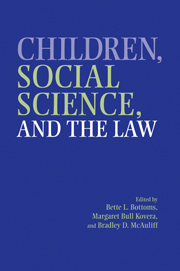Book contents
- Frontmatter
- Contents
- Acknowledgments
- Contributors
- 1 Children, Social Science, and the Law: An Introduction to the Issues
- PART I CHILDREN'S RIGHTS, THEIR CAPABILITIES, AND SOCIETY'S RESPONSIBILITIES TO CHILDREN
- PART II CHILDREN AND FAMILY CHANGE
- PART III JUVENILE AGGRESSION AND JUVENILE JUSTICE
- 9 Juvenile Transfer to Adult Court: How Can Developmental and Child Psychology Inform Policy Decision Making?
- 10 Youth Violence: Correlates, Interventions, and Legal Implications
- 11 Capacity, Competence, and the Juvenile Defendant: Implications for Research and Policy
- PART IV CHILDREN AS VICTIMS AND WITNESSES
- PART V CONCLUSIONS AND FUTURE DIRECTIONS
- Author Index
- Case Index
- Subject Index
- References
10 - Youth Violence: Correlates, Interventions, and Legal Implications
Published online by Cambridge University Press: 24 July 2009
- Frontmatter
- Contents
- Acknowledgments
- Contributors
- 1 Children, Social Science, and the Law: An Introduction to the Issues
- PART I CHILDREN'S RIGHTS, THEIR CAPABILITIES, AND SOCIETY'S RESPONSIBILITIES TO CHILDREN
- PART II CHILDREN AND FAMILY CHANGE
- PART III JUVENILE AGGRESSION AND JUVENILE JUSTICE
- 9 Juvenile Transfer to Adult Court: How Can Developmental and Child Psychology Inform Policy Decision Making?
- 10 Youth Violence: Correlates, Interventions, and Legal Implications
- 11 Capacity, Competence, and the Juvenile Defendant: Implications for Research and Policy
- PART IV CHILDREN AS VICTIMS AND WITNESSES
- PART V CONCLUSIONS AND FUTURE DIRECTIONS
- Author Index
- Case Index
- Subject Index
- References
Summary
Although the media spotlight certainly exaggerates the reality, there is no doubt that violence by and against youth is an enormous social problem. Nearly one in six of all violent crime arrests in 1997 involved a juvenile under 18 years of age (FBI, 1997). Arrest rates for violent crimes among juveniles increased 49% between 1988 and 1997 compared with an increase of 19% among persons 18 years of age and over. However, recent data suggest that juvenile arrests for murder and other violent crimes may have peaked in 1994 (Sickmund, Snyder, & Poe-Yamagata, 1997). Moderate decreases in 1995, 1996, and 1997 are evidence of the continuing downward trend in juvenile arrests for violent crimes (FBI, 1996, 1997). Although violence is pervasive in American society, not all groups are equally affected. African American youth are significantly overrepresented among victims and perpetrators of violent crimes (Reiss & Roth, 1993). Arrest data indicate that African American youth account for 52% of youth arrested for violent crimes, even though they make up only 15% of the juvenile population (Dryfoos, 1990). However, data on self-reported violent offenses demonstrate a much narrower difference between the prevalence of violence between Blacks and Whites (Elliot, 1994).
We begin this chapter with a discussion of the difficulties surrounding definitions of violence. Then we review the correlates of youth violence by examining the societal, neighborhood, school, peer, family, and individual factors that predict violent behavior.
- Type
- Chapter
- Information
- Children, Social Science, and the Law , pp. 233 - 269Publisher: Cambridge University PressPrint publication year: 2002
References
- 3
- Cited by

